Sports
Liverpool can’t keep winning games like this — or can they?
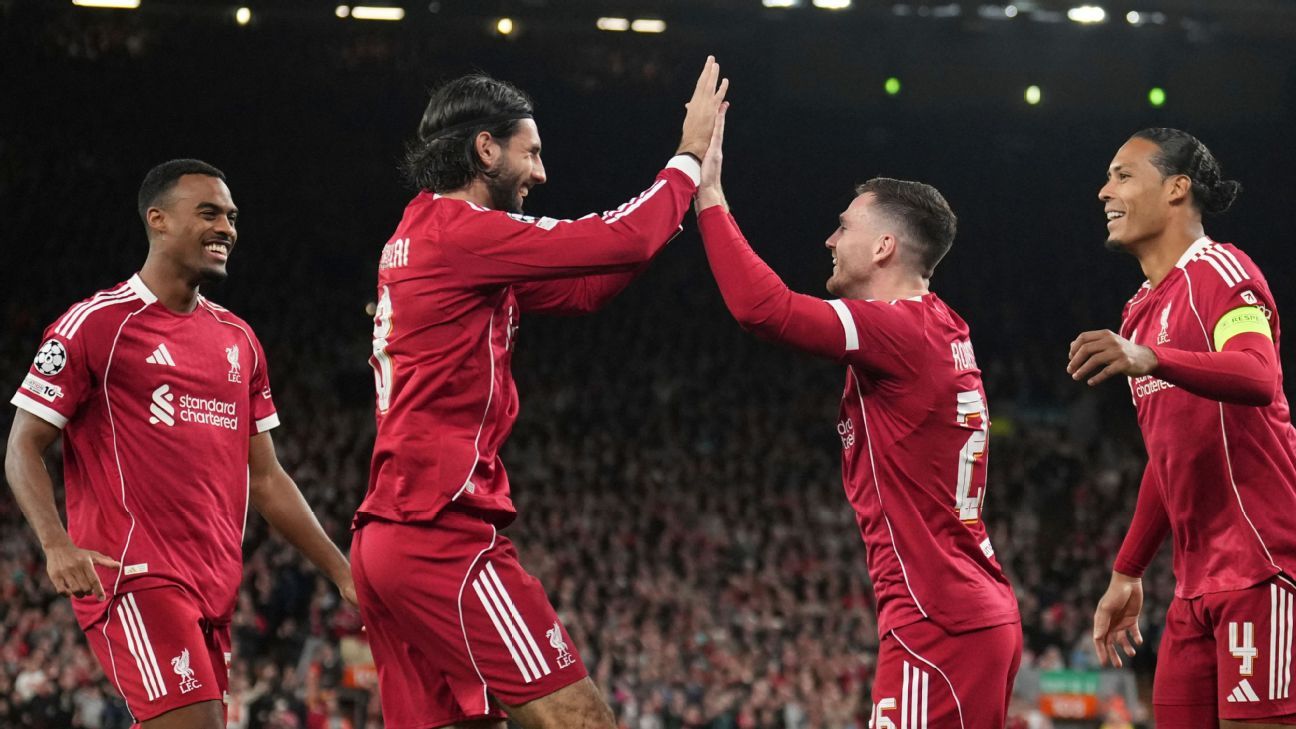
Let’s do a quick blind comparison of two Premier League teams from this current season.
Team A still hasn’t lost a game. In fact, it hasn’t earned a draw. In fact, it hasn’t even trailed in a game. We’re just five matches into the season, and it already has a five-point lead atop the table. That’s tied with one other side for the biggest lead through five games in the history of the Premier League. And the other team to do it? It won the title by 18 points.
Meanwhile, Team B has scored 11 goals and conceded five. That gives it a plus-six goal differential, the third-best mark in the league. At least 50 other teams in Premier League history have outscored their opponents by more goals through five matches, and the same holds true for goals scored and goals conceded. It’s good … but it’s not great. Last season, Tottenham had a better goal differential than this team through five matches, and they finished one place clear of the relegation zone.
So, which team would you rather be?
It’s a trick question, of course: Team A and Team B are the same team.
Liverpool are undefeated this season, but they’ve still only won one match by more than a goal. And even in that one, the season-opener against Bournemouth, they didn’t take the lead for good until the 88th minute.
Liverpool beat Newcastle on the road thanks to a goal in the 100th minute from 16-year-old Rio Ngumoha. They took down Arsenal with an 83rd-minute free kick by Dominik Szoboszlai. They needed a 95th-minute penalty from Mohamed Salah to beat Burnley. Virgil van Dijk headed in the winner in the 92nd minute of their Champions League opener against Atletico Madrid. And Hugo Ekitike‘s 85th-minute tap-in-turned-red-card secured a 2-1 win against Southampton in the Carabao Cup.
Liverpool have somehow been even better and much worse than anyone would’ve predicted at the start of the season. So, let’s ask the same question that rival fans seem to be screaming, week after week: They can’t keep this up … right?
– First-month grades for all 20 Premier League teams
– Soccer’s most stylish 2025-26 kits: The world’s best jerseys
– Early-season angst check: Who needs to be worried?
Why do Liverpool score so many late goals?
Whenever a team continues to win in such an improbable fashion, it is attributed to a club’s superior, never-say-die mentality. That was the case with Manchester United under Sir Alex Ferguson. It’s what happens with Real Madrid in the Champions League every year. And it frequently felt true with Liverpool under Jurgen Klopp — and now it seems true under Arne Slot, too.
The stats seem to back that up. Since the Premier League was created in the early 90s, Liverpool have won 43 games with a goal in the 90th minute or later — a whopping 13 more than any other side.
So, Liverpool are better at winning games late than everyone else — or are they? At least, I’m not sure that’s what that statistic is telling us. There’s a more economic explanation for it.
Liverpool have the third-most points of any club in the Premier League era. On the whole, Arsenal and Manchester United have been better than Liverpool since 1993, so those two clubs haven’t had to win as many late games. Then, when Manchester City and Chelsea entered the picture with their wealthy new owners in the 2000s, they typically had better and more expensive squads than Liverpool. Before that, they weren’t anywhere near as competitive as Liverpool.
So, Liverpool sit in that sweet spot where they won lots of games and therefore, they won lots of late games. But they also weren’t as talented as the other teams that won lots of games, so a higher proportion of their wins came from late goals.
There’s definitely an Anfield effect here — opposing players tend to agree that it’s the hardest place in England to play. So, if you combine that with the fact that, for most of the Premier League era, Liverpool have been competing with richer and better teams, then it makes sense that they’ve needed to use every minute of every game to keep up.
Now, that isn’t quite as true anymore. They spent a net of $309 million on transfer fees this past summer. They made $773m in revenue in 2023-24, and some estimates rank them as the fourth-most valuable club in the world after Manchester United, Real Madrid, and Barcelona. Per FBref, they have the sixth-highest wage bill in the world.
So what’s the explanation for all of the late winners this season?
Liverpool have been the best team in the league when the score is tied in the second half of matches. They’ve scored four goals and conceded zero — both best or tied-for-best marks in the Premier League. They’ve also attempted 28 shots (nine more than anyone else) and conceded only five. The 23-shot margin is by far the largest in the league; no one else is above 10. Part of the reason they’ve scored so many late winners is that they’ve heavily tilted the field whenever they’ve needed a late winner.
Here’s how it looks for the whole league when we compare xG (expected goals) created and xG conceded in the second half when the score is tied:
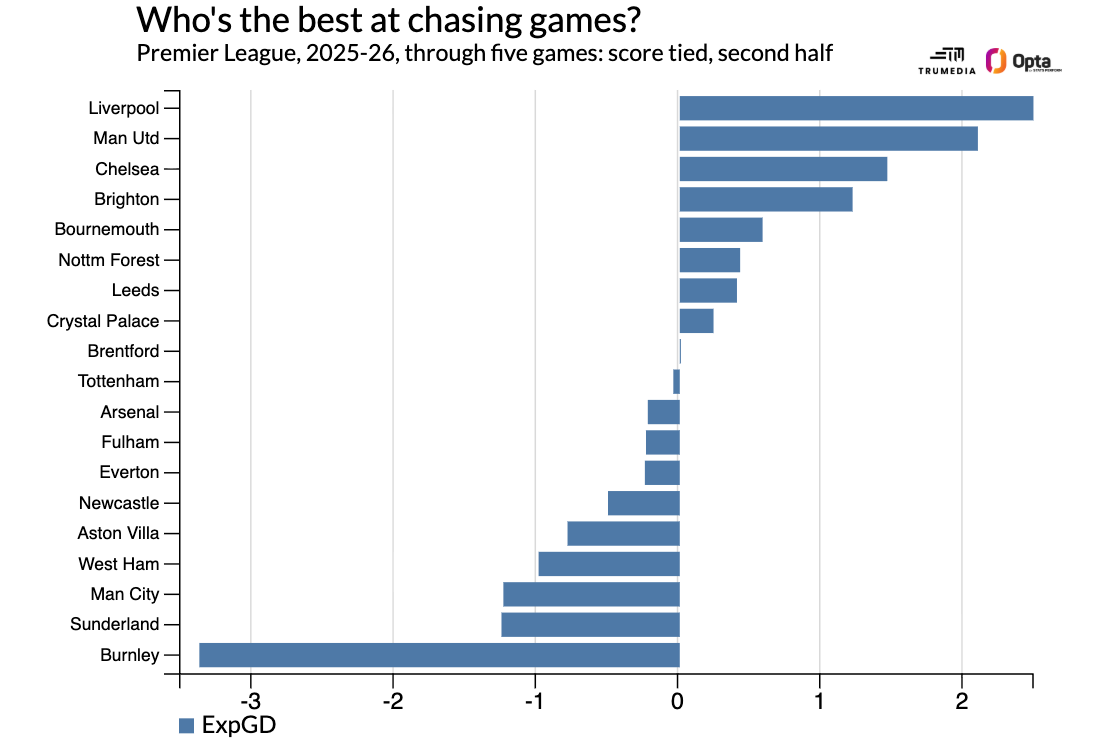
Liverpool have created 2.49 xG and conceded just 0.11 at this game-state. The defense allows almost nothing, while the attack creates a ton. That’s great, but it still doesn’t answer the bigger, more important question.
Why do Liverpool need all of these late comebacks?
There are two problems with all of these late-game, tied-score stats: (1) we’re already cutting a small sample of five matches into an even smaller one, and (2) not everyone has played the same number of minutes with the score tied in the second half. If you’re one of the best teams in the world, ideally, you’re not spending too much time there.
Liverpool have needed so many late winners mainly because they’ve been quite poor whenever they’ve taken the lead. They’ve conceded 25 shots and attempted 25 when they’ve been up by at least a goal.
Now, it’s normal for teams not to register as many attempts once they’re leading, but good teams usually make up for that by creating higher-quality attempts than normal when they do attack because their opponent has to push the action and leave space behind the defense. Liverpool, though, haven’t exploited that.
Liverpool’s xG created and conceded is almost exactly even when they’re winning, and it has led to four goals being scored and five being conceded.
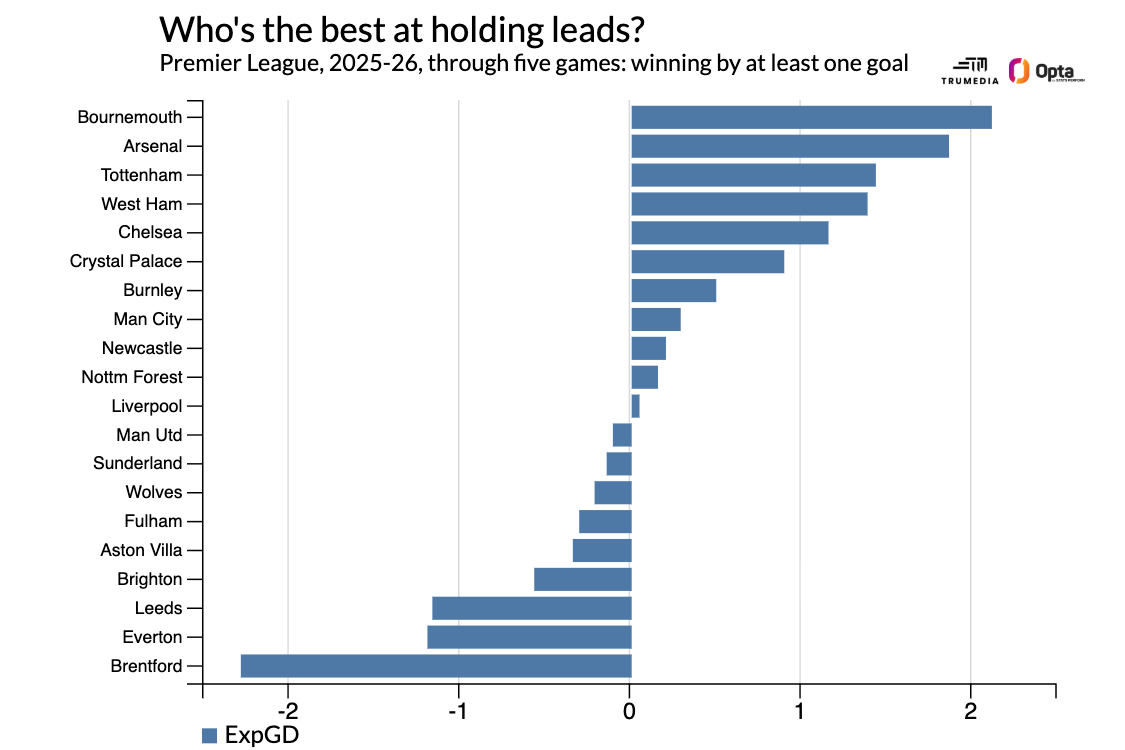
We’re still too early into the season to be too confident about any conclusions, but this sure looks like the profile of a team that has spent a ton of money on attack-first players and has spent most of the season playing with only two true midfielders, neither of whom is defensive-minded.
When opponents aren’t incentivized to attack against Liverpool — when they’re tied and we’re in the second half, a draw is in sight — then the imbalance doesn’t matter. Liverpool keep the ball and their attackers attack, and it all works. But once the other team has to attack, Liverpool can’t control the game anymore. They had 55% of the final-third possession when winning last season; this year, it’s down to 46%.
That’s not too surprising — it might even be by design — but what is surprising is that a team with Florian Wirtz and Mohamed Salah and Dominik Szoboszlai and Hugo Ekitike and Alexander Isak still hasn’t made teams really pay on the counter-attack. Liverpool’s xG per shot when they’re leading is 0.10 — or slightly below the league average for teams that are ahead. Last season, it was up at 0.13.
So what does it all mean?
Though Liverpool’s matches have been strangely partitioned this season, it’s better to look at everything together, and history tells us as much. From the previous 10 Premier League seasons, I looked at a number of statistics from Stats Perform for the first five matches to see what best correlated with points won over the final 33 games of the season. Looking at only certain game states made the predictions worse, as did removing what you might think would be the randomness of penalties.
The stat that best correlated with rest-of-season stats was “adjusted goal differential” — the blend of 70% of Stats Perform’s expected goals and 30% actual goals that I’ve referenced countless times before. It was more accurate than just goals, just expected goals, and just points. The correlation (also known as “r-squared”) was 0.44, which means that 44% of the variation between the points every team has won over the final 33 games over the past 10 seasons can be explained by each team’s adjusted goal difference through the first five games.
Here’s how that looks:
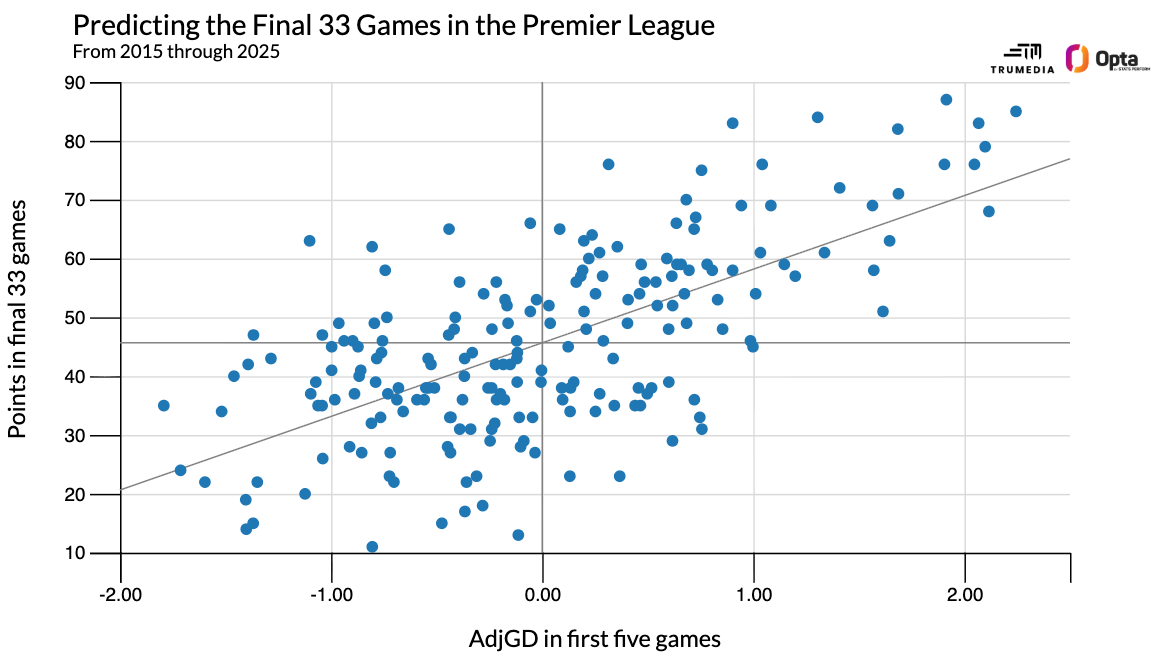
And here’s how things look across the league so far this season, by adjusted goal differential:
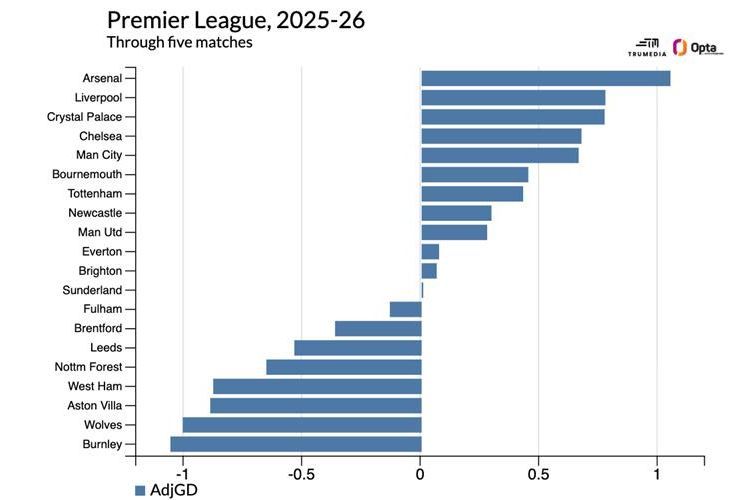
Ironically, this is exactly what happened the last time Liverpool won the league in 2019-20. The following season, their adjusted goal differential through the first five games was plus-0.78, the same number they’ve got now. They then won 59 more points over the rest of the season and finished in third.
That team, though, soon lost Virgil van Dijk for the season, followed by their second- and third-choice center backs, Joel Matip and Joe Gomez, respectively. This team has still had its club-record signing, Alexander Isak, on the field for only 24 total Premier League minutes. And though the one match he started also required a last-second winner, at home against Atletico Madrid in the Champions League, it was also the one game where Liverpool dominated after they led. With Liverpool leading, the shot count was close, 12 to 9 in favor of the hosts, but Liverpool created 1.32 expected goals to Atletico’s 0.38.
As it stands, though, Arsenal have played about as well as Liverpool did last season, while Liverpool have played about as well as Arsenal did. Their current adjusted goal differentials are nearly the same as the other team’s full-season marks from last year. Over the past 10 seasons, the best a team has done while playing at Liverpool’s current level — somewhere between a 0.5 and 0.8 adjusted goal differential — was Leicester’s 81 points in their 5,000-to-1 championship season. While the worst a team with a plus-1-or-better adjusted goal differential has done was Liverpool’s 78 points in 2017-18.
Now, it could happen, but the overwhelmingly likely outcome of Liverpool and Arsenal maintaining their current performance levels is that Arsenal wins the league. Given how Bukayo Saka, William Saliba, and Martin Odegaard have already missed significant time and how they’ve already played Liverpool and Manchester City, it seems unlikely that Arsenal decline too much from here on out. So, hang on to their current lead, Liverpool will have to improve; they’ll need to stop falling apart once they take a lead, and they’ll need to start winning some matches before the 85th minute.
But while all those last-second winners can’t be relied upon for the rest of the season, they did happen. Dominik Szoboszlai briefly harnessed the power of gravity against Arsenal, in a way no Arsenal player did against Liverpool. Szoboszlai, too, had the presence of mind to dummy a pass and create a massive opening for Rio Ngumoha to slot home the winner against Newcastle. And because Liverpool have executed in so many of these high-leverage moments already, they’ve built a sizable cushion.
They need to be better from now through the end of the season if they want to win the title, but they don’t actually need to be better than Arsenal. They just need to be four points worse.
Sports
Mejbri charged for allegedly spitting at Leeds fans

Burnley midfielder Hannibal Mejbri has been charged with misconduct by the English Football Association after allegedly spitting at or in the direction of Leeds United supporters last month.
The matter relates to an incident in the 67th minute of the Clarets’ 2-0 Premier League win over Leeds at Turf Moor on Oct. 18.
Mejbri had been among the substitutes at the time of the alleged incident. He went on to enter the game in the 83rd minute and was booked following a clash with Leeds defender Gabriel Gudmundsson.
An FA statement added: “Hannibal Mejbri has until Friday 28 November to provide a response.”
Sports
NHL trendspotting: Which first-month shock teams will stay red hot or ice cold?
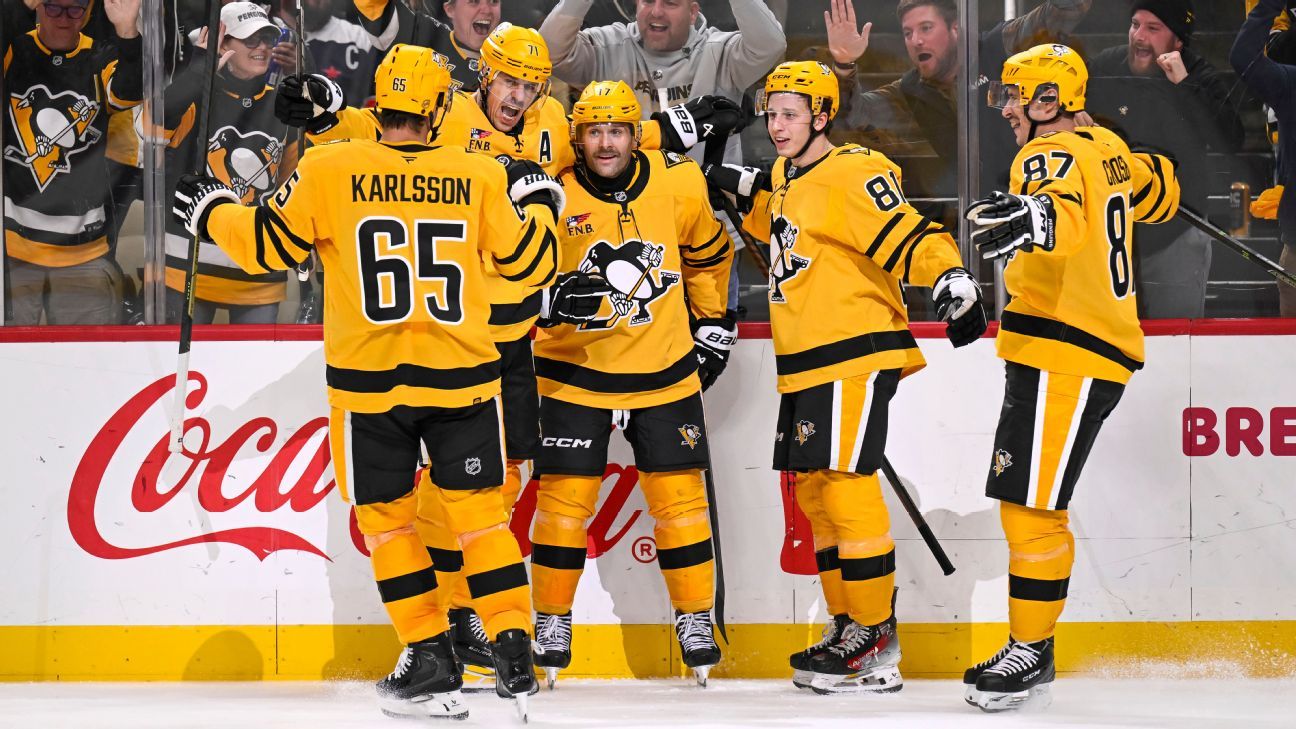
A month into the NHL season, the playoff race is already shifting in unexpected ways. While many of the highest postseason chances belong to the usual suspects — as do the lowest (sorry, San Jose Sharks) — some are the property of rising teams surging ahead of schedule, versus others who’ve stumbled hard out of the gate.
Using playoff odds, season stats, Elo ratings and other indicators of team quality, we can see which clubs have overachieved or underwhelmed the most relative to preseason expectations.
Some of these early sources of curiosity (for good or bad) look built to last. But others? Not so much.
Let’s dive into the biggest surprises to see which look real, and what they say about the league’s shifting balance of power.

Pleasant surprises
![]()
Year 1 of Joel Quenneville’s tenure behind the bench in Anaheim has been nothing less than a rousing success early, with the Ducks ranking No. 1 in goals per game and No. 4 in goal differential overall. To say that’s a massive departure from their usual norm is an understatement; this team had previously ranked no better than 24th in scoring or 21st in goal differential in any season since 2018-19.
But the forward corps of Cutter Gauthier, Leo Carlsson and Troy Terry has been among the most productive teammate trios in the league (with 49 combined points), while former Rangers captain Jacob Trouba has solidified the blue line and Lukas Dostal has supplied strong goaltending.
Suddenly a team that hadn’t made the playoffs or posted a winning record in any of the previous seven seasons holds one of the best records in the NHL, with a 61% probability to make the playoffs.
Chance to continue: Moderate.
Because hockey is so prone to randomness in small samples, 12 games is a bit early to render a full verdict on the Ducks officially being back; they still rank No. 26 in the Elo ratings, for instance, which move slowly but are optimized to predict future games.
But it’s already clear that this team is better than it has been in a long time. (Case in point: a traditionally offense-starved team is generating far more chances than in recent years.) With the league’s third-youngest roster, it finally feels as if the Ducks are building toward something sustainable.
![]()
The Pens were written off so completely before this season that their main questions were when or if Sidney Crosby and Erik Karlsson would be traded — and whether Evgeni Malkin might just retire after the season. There didn’t seem to be any way that a team that had been the oldest in hockey — and sixth-worst by goals-per-game differential — in 2024-25 could actually contend a season later.
But that’s exactly what has happened to start 2025-26, as Sid the Kid has continued to play at an elite level at age 38, Malkin and Karlsson have rediscovered what once made them great, newcomers Justin Brazeau and Anthony Mantha have added scoring punch and the tandem of Arturs Silovs and Tristan Jarry has stood out in net.
Remarkably, Pittsburgh ranks in the top five in goal differential — a first for the club since 2020-21 — and they have a 56% chance at returning to the playoffs after a three-year absence.
Chance to continue: Low to moderate.
As great a story as the fountain-of-youth Penguins have been to start the season, there are some warning lights flashing that they might not be able to keep it up all season. The first is, obviously, age: The team still ranks as the league’s fifth-oldest roster, with a number of veterans playing key roles. Among their top 12 players by goals above replacement, eight of them — Malkin, Crosby, Karlsson, Mantha, Jarry, Kris Letang, Bryan Rust and Rickard Rakell — are age 30 or older this season.
Plus, the team is reliant on a few unsustainably high percentages, including a league-high power-play success rate of 35.9% and both the NHL’s fifth-highest team shooting percentage (13%) and second-best save percentage (.909). Strip away those, and this is a team outside the top 20 in zone-time percentage and share of total scoring chances in their games.
0:34
Arturs Silovs makes terrific glove save for Penguins
Arturs Silovs makes terrific glove save for Penguins
![]()
Given a fresh start with a new name this season, the Mammoth are skating full speed into what seems like a bright franchise future.
The team currently ranks top 10 in points percentage and goals-per-game differential, with the league’s 11th-best offense and defense. Prime-age (or younger) cornerstones Nick Schmaltz, Logan Cooley, Mikhail Sergachev, Dylan Guenther and Clayton Keller are all on pace for the best seasons of their careers by goals above replacement (GAR), while newcomers JJ Peterka and Nate Schmidt are also making a difference.
The Mammoth have the league’s best defense in terms of fewest shots allowed per game, and they could be even scarier if they ever get their goaltending in order. Right now, Utah has a 69% chance to make the playoffs for only the second time since 2011-12 (if we include their previous era as the Arizona Coyotes).
Chance to continue: High.
The Mammoth are no fluke. If anything, they should probably be doing even better than their .643 points percentage suggests.
The team ranks seventh in the share of shot attempts in their games, eighth in the share of scoring chances and sixth in the share of expected goals. Furthermore, Utah has done it against the league’s third-hardest schedule by average opponent Elo rating — which improves to 27th-hardest going forward.
The netminding duo of Karel Vejmelka and Vitek Vanecek have been mediocre so far, ranking 25th in save percentage as a team, but the skaters have been producing chances and playing airtight defense.
It’s easy to view Utah as a team that more established opponents would not be excited to face in a first-round series.
![]()
As we wrote when talking about the teams with the most to prove this season, the Red Wings have teased a playoff return too many times to be given the full benefit of the doubt this early.
That said, Detroit’s players are starting to click, with Dylan Larkin playing like a long shot MVP contender to lead a group that also includes Alex DeBrincat and the burgeoning trio of Lucas Raymond, Moritz Seider and Emmitt Finnie.
Nothing about the Wings’ résumé jumps off the page. Even after their improvement, they still rank only 15th in goals-per-game differential, but that would be their best mark since the second-to-last season of their 25-year playoff streak that ended after the 2015-16 season.
Chance to continue: Moderate.
With a 59% playoff chance, the Red Wings are still on the skate-blade’s edge of making the playoffs — and their middle-of-the-road rankings don’t make it seem like that stressful ride will change much over the rest of the season.
But there are reasons to think Detroit can shore up their chances a bit more from here. In terms of expected goals (a measure of controlling play that filters luck out of shooting and save percentages), they rank No. 9 in the share predicted to go their way in games. There’s also hope for better goaltending, as veterans Cam Talbot and John Gibson have a better track record than their average-at-best performances this season suggest.
Finally, the schedule should get a bit easier from here, going from fourth-hardest so far to 16th-hardest going forward.
0:48
Moritz Seider tallies goal vs. Sharks
Moritz Seider tallies goal vs. Sharks
Not-so-pleasant surprises
![]()
After a remarkable late-season run to the playoffs under new coach Jim Montgomery last season — during which the Blues somehow produced a better record (21 wins, nine losses) over the final 30 games of the regular season than the Cup-winning 2018-19 team did (20-10) — St. Louis appeared poised to build on that success this season.
But at 5-8-3 so far, the Blues hold the league’s second-worst record and they also sit last in goals allowed per game and goals-per-game differential, having lost the most playoff probability since opening night (minus-34%) of any team.
All of the team’s top skaters — Jordan Kyrou, Robert Thomas, Pavel Buchnevich, Dylan Holloway, Colton Parayko, Cam Fowler — have undershot GAR expectations by significant margins, while goaltender Jordan Binnington has been one of the worst netminders in the NHL. (His best act of protecting the puck might’ve been swiping Alex Ovechkin‘s 900th goal from the ice and into the back of his pants before having to return it.)
Chance to continue: Low to moderate.
Perhaps surprisingly for a team that has performed so badly over the season’s first month, St. Louis is not in terrible shape. The Blues still have a 32% playoff probability, owing to how the rest of the West basement hasn’t exactly been impressive either, and there’s a good chance the Blues start winning more games soon.
The team has been one of the unluckiest in the league by PDO, which measures which teams are unduly benefiting (or not) from shooting and save percentages. Cut through that noise, and St. Louis ranks No. 7 in their share of total scoring chances in games, 11th in their share of expected goals and fourth in offensive zone time percentage.
If they can get better goaltending — right now, Binnington and Joel Hofer combine to rank 31st in save percentage — the Blues are very capable of turning things around.
![]()
The Flames have been on parallel tracks with the Blues for a while, for whatever reason, complete with similar late-season changes that landed the two teams in a tie for the West’s final playoff spot in 2024-25 (which St. Louis won on a tiebreaker). Now, they have the two biggest losses of playoff chances in the league to start 2025-26.
The only difference is that Calgary’s goaltenders — Dustin Wolf and Devin Cooley — have actually done an admirable job under the circumstances this season, playing behind a defense that allows 30.5 shots per game and with some of the league’s worst goal support — the Flames’ 2.06 goals-per-game rate ranks last in the league.
This team needed either more scoring punch or a more stingy approach at the other end, but so far it has received neither.
Chance to continue: Moderate.
The Flames are in a less enviable position than the Blues because their dip in playoff odds has already landed them at 18%, roughly half as likely as the Blues’ chances. They’re also starting from a position of little hope for an offensive turnaround; the team ranked 29th in goals per game last season, and added little of note over the summer, so they’re banking on whatever positive regression is still left in Nazem Kadri, Jonathan Huberdeau, MacKenzie Weegar, Blake Coleman and Yegor Sharangovich.
Otherwise, Calgary does have a few factors in its favor: It looks better by scoring-chance and expected-goals shares than its bad record would indicate, and the Flames will go from facing the No. 1 most difficult schedule to No. 30 from here, the biggest scheduling easement in the league.
![]()
A few weeks ago, we wrote about how the Rangers were under some of the most pressure of any team to prove that last season’s disaster was a one-off from a franchise that typically has been the model of consistent quality over the previous two decades.
But their start in 2025-26 has done little to dispel the idea that something is fundamentally wrong with the Broadway Blueshirts.
New York currently ranks 20th in goals-per-game differential — which would be only their third season ranking so low since the 2005 lockout — and the way they’ve done it is downright bizarre. By goals per game, they have the best defense in the league, yet also the second-worst offense. A similar feat hasn’t been done since the 1963 Chicago Blackhawks finished first on defense and sixth (hey, it was the Original Six era) on offense.
Chance to continue: Low.
Like St. Louis, the Rangers have reasonably decent playoff odds (41%) despite currently sitting near the bottom of the pile in the East standings. They have too much offensive talent on hand — Artemi Panarin, J.T. Miller, Mika Zibanejad, among others — to sit last in scoring, after six consecutive seasons ranking 16th or better at that end. Though they might not finish first in goals allowed per game either, that extreme is a lot more fitting with this team’s track record than the 31st-ranked offense.
In terms of controlling play, the Rangers rank fourth in scoring-chance share, fifth in expected-goals share and seventh in offensive zone-time share. When they start improving upon their league-worst 7.8% shooting percentage, the Rangers should start winning more games, and their playoff chances will rise.
![]()
Before the season, the Wild signed Kirill Kaprizov to the richest contract in NHL history (which kicks in next season) because the data said he was as indispensable as any star: Since 2020-21, he’d driven roughly one-third of Minnesota’s offense, and in 2024-25 the team scored like a borderline top-10 team when he played and cratered without him. The logic around Kaprizov’s value still seems sound; he’s currently on pace for 45 adjusted goals and 105 adjusted points.
But while he’s holding up his end, the goaltending, defense and depth scoring aren’t, as Minnesota ranks just 20th in goals per game, despite Kaprizov’s production, to go with a No. 25 ranking in goals allowed per game and No. 29 in goals-per-game differential.
It’s now looking as if the Wild committed a lot to one player who hasn’t been able to overcome the rest of the team’s flaws to start the season.
Chance to continue: Moderate to high.
Minnesota is a confusing mixed bag so far in 2025-26. On the positive side, the Wild are a top-six team by share of offensive zone time, which would seem to suggest the potential for better results when their 98.9 PDO — 25th in the league — gets straightened out. (PDO is a highly luck-driven stat that tends to regress to the mean of 100.0 over time.)
But the Wild also haven’t done much with all that zone time, ranking 23rd in scoring-chance share and 25th in expected-goals share, perhaps indicating the need for tactical adjustments from coach John Hynes.
Also on the negative side: The Wild play a slightly tougher schedule from here, and with 24% playoff chances, they have little margin for error.
Sports
CFP Bubble Watch: Who’s in? Who’s out? Who’s close after the second ranking?
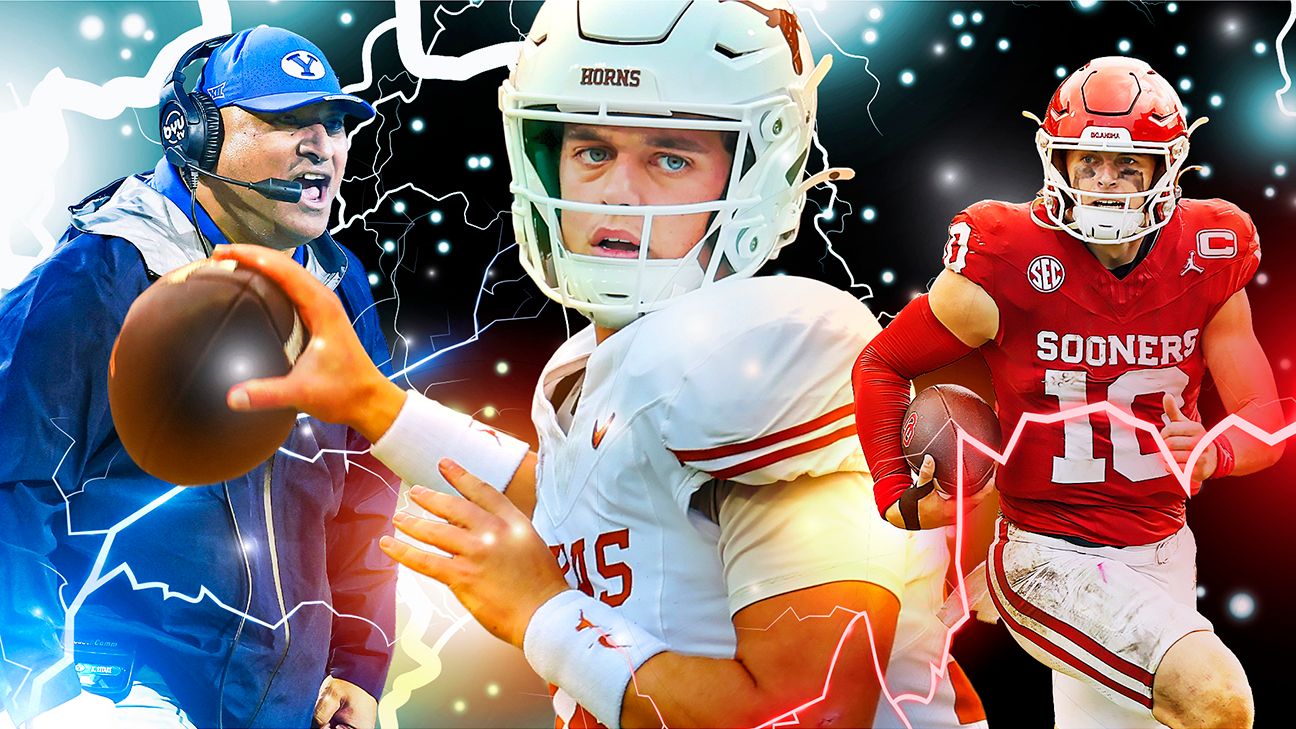
There wasn’t much movement Tuesday night in the College Football Playoff’s second ranking, with the top five staying the same, but a big winner might have been the entire state of Texas.
The No. 3 Aggies are still in a first-round bye position, Texas Tech rose to No. 6 after its convincing win against BYU and Texas moved into a safer spot at No. 10 thanks to BYU dropping to No. 12.
And in the state of Florida, No. 15 Miami regained its position as the committee’s top ACC team, while No. 24 South Florida is the first Group of 5 team to appear in the CFP top 25 this season.
The Bubble Watch accounts for what we have learned from the committee so far — and historical knowledge of what it means for teams clinging to hope. Teams with Would be in status below are in this week’s bracket based on the committee’s second ranking. For each Power 4 conference, we’ve also listed Last team in and First team out. These are the true bubble teams hovering around inclusion. Teams labeled Still in the mix haven’t been eliminated, but have work to do. A team that is Out will have to wait until next year.
The conferences below are listed in order of the number of bids they would receive, ranked from the most to least, based on Tuesday night’s second committee ranking.
Jump to a conference:
ACC | Big 12 | Big Ten
SEC | Independent | Group of 5
Bracket
SEC
Would be in: Alabama, Georgia, Ole Miss, Texas, Texas A&M
![]()
Last team in: Texas. The Longhorns earned a promotion to No. 10 after BYU dropped to No. 12. They had a well-timed bye on Saturday to prepare for Georgia, and no team has a better chance to impress the selection committee this month than Texas. The Longhorns will face two top-five opponents in No. 5 Georgia and No. 3 Texas A&M, but with a bad loss to Florida to go along with the defeat by Alabama, Texas is still on the bubble even though it could appear to be in a safer spot this week. If Texas finishes as a three-loss team, it’s conceivable it could be ranked in the top 12 but would likely face a similar situation to Alabama last year. The Tide was the committee’s top three-loss team but got bumped out of the top 12 during the seeding process to make room for a conference champion that earned a guaranteed spot. With the ACC and Group of 5 champions currently outside of the committee’s top 12, it looks like the No. 11 and No. 12-ranked teams would be excluded — and that’s probably the ceiling for a three-loss Texas team.
![]()
First team out: Oklahoma. The Sooners had a bye last week to prepare for Alabama, which is essentially a playoff elimination game for OU. Unlike Texas, the Sooners likely wouldn’t have enough on their résumé to compensate for a third loss, even if it were on the road to a top-four team. Their best wins are against Michigan, Auburn and Tennessee — and they would lose the head-to-head tiebreaker to Texas if their records remain the same.
Still in the mix: Vanderbilt. The Commodores need some chaos to get back into the conversation, but the overtime win against Auburn kept their hopes alive. Vandy isn’t going to play in the SEC championship game, and its only remaining opponents are against Kentucky and Tennessee. Texas, Oklahoma and Vanderbilt are jockeying for a fifth at-large bid for the SEC — which isn’t guaranteed — and Texas has the head-to-head win over Vandy. If OU and Texas both lose, though, and Vandy wins out, Vandy could move up on Selection Day.
Out: Arkansas, Auburn, Florida, Kentucky, LSU, Mississippi State, Missouri, South Carolina, Tennessee
Big Ten
Would be in: Indiana, Ohio State, Oregon
![]()
Last team in: Oregon. The Ducks did exactly what the committee needed them to do Saturday — earn a statement road win against a CFP top-25 team in Iowa. While Oregon remained safe at No. 8 on Tuesday night, it doesn’t mean the Ducks are a lock for the playoff. What if they lose to USC? If USC runs the table, its chances of reaching the playoff would skyrocket to 80% according to the Allstate Playoff Predictor — ahead of Oregon (77.5%), which could still get in WITH USC, depending on how far the committee drops them after a second home loss. How the game unfolds will also factor into its decision.
![]()
First team out: USC. The Friday night victory against Northwestern (wait, he’s not the punter!) kept the Trojans’ playoff hopes alive. They avoided an upset on a short week while NU had a bye week to prepare. Before USC even gets to Oregon, though, it has another extremely difficult home game Saturday against Iowa. If USC and Michigan run the table, it could create a significant debate in the committee meeting room because USC would have the head-to-head win, but Michigan would have defeated No. 1 Ohio State for the best win in the country. USC also has its own tiebreaker problem, as it lost the head-to-head result at Notre Dame.
Still in the mix: Michigan. The Wolverines have two respectable road losses — to USC and Oklahoma — but they have a chance at the best win in the country if they can beat rival Ohio State for a fifth straight season. If Michigan runs the table, it will have a 46% chance to reach the playoff — ninth best in the country, independent of other results. The head-to-head tiebreakers could be a factor when ranking Michigan against USC and Oklahoma, but at 10-2 with a win against the committee’s top team, the Wolverines would be in the discussion.
Out: Illinois, Iowa, Maryland, Michigan State, Minnesota, Nebraska, Northwestern, Penn State, Purdue, Rutgers, UCLA, Washington, Wisconsin
Big 12
Would be in: Texas Tech
![]()
Last team in: Texas Tech. The Red Raiders separated themselves from the rest of the league with Saturday’s resounding triumph over BYU, which is one of the best wins in the country. With the bump two spots to No. 6, the Red Raiders are within striking distance of a first-round bye if they can move into one of the top four spots on Selection Day. It’s not inconceivable considering Ohio State and Indiana are likely to play each other in the Big Ten title game and Alabama still has a tricky game against Oklahoma on Saturday. This position also gives Texas Tech a little cushion should it lose in the Big 12 championship game.
![]()
First team out: BYU. The biggest movement in the ranking was with BYU sinking to No. 12, where it would be excluded from the playoff if it were today to make room for No. 12 South Florida, which is the projected Group of 5 champion. If BYU wins the Big 12, which is still a realistic scenario, it will clinch a spot in the playoff regardless of where it’s ranked. BYU’s chances of earning an at-large bid, though, took a significant hit Saturday because of how it lost to Texas Tech — with a subpar offensive performance that included three turnovers.
Still in the mix: Cincinnati, Utah. Cincinnati made its first appearance this week at No. 25 in the committee’s ranking. The Bearcats — and Utah — have at least a 17% chance of reaching the Big 12 title game. Any Power 4 team with a realistic shot at playing for its conference title has a chance at the 12-team field because the five highest ranked conference champions are guaranteed bids. Cincinnati has only one Big 12 loss (the other was the season-opener to Nebraska in Kansas City), but it was a 45-14 drubbing by Utah. The Bearcats have a chance at a statement win on Nov. 22 when they host BYU. There’s a lot of respect within the committee meeting room for Utah, but with Baylor, Kansas State and Kansas left on the schedule, winning the Big 12 is its most realistic path to the playoff.
Out: Arizona, Arizona State, Baylor, Colorado, Houston, Iowa State, Kansas, Kansas State, Oklahoma State, TCU, UCF, West Virginia
ACC
Would be in: Georgia Tech
![]()
Last team in: Georgia Tech. Even though Miami checks in as the committee’s top ACC team though at No. 15, Georgia Tech has a far better chance of reaching the ACC title game. The ACC continues to struggle with its top two teams — Virginia and Louisville — losing Saturday night to unranked opponents Wake Forest and Cal, respectively. That means Georgia Tech and Duke (yes, Duke) are the two most likely teams to play for the ACC title, according to ESPN Analytics. Georgia Tech still has an opportunity to quiet its naysayers, though, when it plays rival Georgia in the regular-season finale. While it would be one of the best wins in the country, it might not be enough to catapult the Yellow Jackets back into the field if they don’t win the ACC. The ACC isn’t in danger of being excluded from the playoff — its champion will get in — but it’s becoming increasingly unlikely that the league runner-up will join it.
![]()
First team out: Miami. The Canes got promoted to No. 15 ahead of Louisville and Virginia despite a loss to the Cardinals. Miami has a 5.9% chance of reaching the ACC title game and a 10% chance to reach the playoff, according to ESPN Analytics. Miami still has a lot of work to do to earn an at-large bid, and equally as important is hoping teams above it loses.
Still in the mix: Duke, Louisville, Pitt, SMU, Virginia. All of these teams have at least a 5% chance to still reach the ACC title game, according to ESPN Analytics. Of all of the teams listed here, though, Georgia Tech, Virginia, SMU and Miami lead the ACC with at least a 10% chance to reach the CFP.
Out: Boston College, Cal, Clemson, Florida State, North Carolina, NC State, Stanford, Syracuse, Virginia Tech, Wake Forest
Independent
![]()
Would be in: Notre Dame. The Irish ranked No. 9 on Tuesday night, earning a promotion thanks to BYU dropping to No. 12. The Fighting Irish dominated Navy on Saturday, which was playing without injured starting quarterback Blake Horvath. It was Notre Dame’s seventh straight victory since starting the season 0-2. The committee continues to consider that those two losses were by a total of four points to two CFP top-25 teams, including No. 3 and unbeaten Texas A&M. The committee was also impressed with Notre Dame’s 34-24 win against USC on Oct. 18, and that will continue to resonate with the Trojans now 7-2 after Friday’s victory against Northwestern.
Group of 5
![]()
Would be in: South Florida. After Memphis lost, the two teams most likely to play each other in the American Conference title game are South Florida and North Texas. The Bulls have the best chance (42%) to win the American, according to ESPN Analytics. South Florida is ranked No. 24 this week with wins against Boise State, Florida and North Texas.
Still in the mix: James Madison, North Texas, Tulane. JMU has won seven straight contests, and its lone loss was at Louisville, but the Dukes don’t have anything on their résumé to compensate for it. JMU’s schedule is No. 115 in the country, according to ESPN Analytics. JMU has the second-best chance to reach the CFP (35.8%) behind South Florida (39.7%). North Texas and Tulane are still alive because they both still have at least a 44% chance to reach the American title game.

Bracket
Based on the committee’s second ranking, the seeding would be:
First-round byes
No. 1 Ohio State (Big Ten champ)
No. 2 Indiana
No. 3 Texas A&M (SEC champ)
No. 4 Alabama
First-round games
On campus, Dec. 19 and 20
No. 12 South Florida (American champ) at No. 5 Georgia
No. 11 Miami (ACC champ) at No. 6 Texas Tech (Big 12 champ)
No. 10 Texas at No. 7 Ole Miss
No. 9 Notre Dame at No. 8 Oregon
Quarterfinal games
At the Goodyear Cotton Bowl, Capital One Orange Bowl, Rose Bowl Presented by Prudential and Allstate Sugar Bowl on Dec. 31 and Jan. 1.
No. 12 South Florida/No. 5 Georgia winner vs. No. 4 Alabama
No. 11 Miami/No. 6 Texas Tech winner vs. No. 3 Texas A&M
No. 10 Texas/No. 7 Ole Miss winner vs. No. 2 Indiana
No. 9 Notre Dame/No. 8 Oregon winner vs. No. 1 Ohio State
-

 Tech1 week ago
Tech1 week agoCISOs in court: Balancing cyber resilience and legal accountability | Computer Weekly
-

 Tech1 week ago
Tech1 week agoThe Security Interviews: Colin Mahony, CEO, Recorded Future | Computer Weekly
-

 Fashion1 week ago
Fashion1 week agoGermany’s Adidas achieves highest-ever quarterly sales in Q3 2025
-

 Business1 week ago
Business1 week agoFirst new Amazon electric heavy goods vehicles hit UK roads
-

 Sports1 week ago
Sports1 week agoSources: QB Daniels dislocated elbow in loss
-

 Fashion1 week ago
Fashion1 week agoRare Beauty and BÉIS debut travel-inspired “Beauty On-the-Go” capsule
-

 Business1 week ago
Business1 week agoBusiness news live – Banks bet on interest rate cut and UK bills rise 8% in a year
-

 Tech1 week ago
Tech1 week agoTech Traveler’s Guide to Seattle: Where to Stay, Eat, and Recharge






